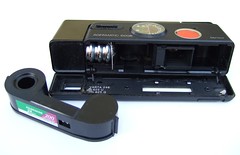Difference between revisions of "110 film"
m (Typogr.) |
(added frame size & cartridge image) |
||
| Line 1: | Line 1: | ||
''See the [[:Category: 110 film]].'' | ''See the [[:Category: 110 film]].'' | ||
| + | {{Flickr_image | ||
| + | |image_source= http://www.flickr.com/photos/89864432@N00/2076627318/in/pool-camerapedia | ||
| + | |image= http://farm3.static.flickr.com/2115/2076627318_8b35a2692f_m.jpg | ||
| + | |image_align= right | ||
| + | |image_text= Typical 110 cartridge & loading slot,<br>on an [[Agfamatic 6008 makro pocket sensor|Agfamatic 6008]] | ||
| + | }} | ||
| + | 110 and [[126 film]] cartridges were launched by [[Kodak]] in answer to consumer complaints about the complications involved with loading and unloading roll film cameras. With the cartridge film you don't have to attach the film leader to a take-up spool and cannot go wrong. The cartridge simply drops into the camera, you close the back, wind on and shoot. Even if you open the camera with a half exposed film inside, the precious exposed film is well protected inside the cartridge. And at the end of the film, you don't have to rewind. | ||
| − | 110 and [[ | + | The 110 cartridge contains 16mm wide film and the small dimensions allowed designers to create small pocketable camera that had an aspect very different from the traditional [[35mm]] cameras, even if they had a marked resemblance with the older [[Subminiature|sub miniature]] 16mm cameras. As the majority of [[:Category: 110 film|110 cameras]] were extremely simple with a single shutter speed and aperture setting and no focusing available, the success of getting prints from these tiny 13x17mm negatives relied on the latitude of the film. Even with today's modern film emulsions and an accurate focusing and exposure mechanism it would be tough to get much more than a 5×7in print from such a tiny negative. Disappointing print results were the main downfall of the format. The outdated films and cameras are still available today but not easily in the American marketplace. |
| − | + | === Links === | |
| − | |||
| − | === | ||
<div class="floatright"> | <div class="floatright"> | ||
{| | {| | ||
|| pocket cameras: | || pocket cameras: | ||
| − | || [http://www.flickr.com/groups/camerapedia/pool/tags/110/ http://static.flickr.com/24/44464024_f13bbb5e71_t.jpg] | + | || [http://www.flickr.com/groups/camerapedia/pool/tags/110/ http://static.flickr.com/24/44464024_f13bbb5e71_t.jpg]<br>''[[Rollei A110]]'' |
| − | || [http://www.flickr.com/groups/camerapedia/pool/tags/110/ http://static.flickr.com/18/22827035_780ebea7e1_t.jpg] | + | || [http://www.flickr.com/groups/camerapedia/pool/tags/110/ http://static.flickr.com/18/22827035_780ebea7e1_t.jpg]<br>''[[Pentax Auto 110]]'' |
| − | || [http://www.flickr.com/groups/camerapedia/pool/tags/110/ http://static.flickr.com/71/204148178_929754b068_t.jpg] | + | || [http://www.flickr.com/groups/camerapedia/pool/tags/110/ http://static.flickr.com/71/204148178_929754b068_t.jpg]<br>''[[Porst Pocketpak 2001|Porst Pocketpak]]'' |
|} | |} | ||
</div> | </div> | ||
Revision as of 20:20, 5 April 2008
See the Category: 110 film.

|
| Typical 110 cartridge & loading slot, on an Agfamatic 6008 |
110 and 126 film cartridges were launched by Kodak in answer to consumer complaints about the complications involved with loading and unloading roll film cameras. With the cartridge film you don't have to attach the film leader to a take-up spool and cannot go wrong. The cartridge simply drops into the camera, you close the back, wind on and shoot. Even if you open the camera with a half exposed film inside, the precious exposed film is well protected inside the cartridge. And at the end of the film, you don't have to rewind.
The 110 cartridge contains 16mm wide film and the small dimensions allowed designers to create small pocketable camera that had an aspect very different from the traditional 35mm cameras, even if they had a marked resemblance with the older sub miniature 16mm cameras. As the majority of 110 cameras were extremely simple with a single shutter speed and aperture setting and no focusing available, the success of getting prints from these tiny 13x17mm negatives relied on the latitude of the film. Even with today's modern film emulsions and an accurate focusing and exposure mechanism it would be tough to get much more than a 5×7in print from such a tiny negative. Disappointing print results were the main downfall of the format. The outdated films and cameras are still available today but not easily in the American marketplace.
Links
| pocket cameras: |  Rollei A110 |
 Pentax Auto 110 |
 Porst Pocketpak |